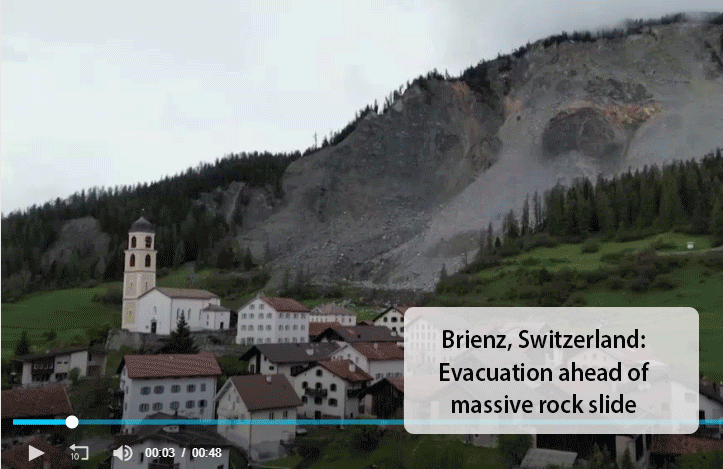Massive rockslide threatening village as alpine “ice glue” melts
TWO MILLION CUBIC YARDS OF ROCK AND DIRT are about to crash down on the village of Brienz in Switzerland’s eastern Alps. The town’s remaining inhabitants have been evacuated in anticipation of the imminent collapse, which is predicted for the next week or so. Authorities had considered construction of a retaining wall to protect the village, but the project was rejected based on calculations that the structure would have to be over 225 feet* high.
Although this is a relatively minor, localized event (unless you live in Brienz) it is a sample of a larger physical destabilization of mountain regions around the world. Just as rapid permafrost thaw is compromising the very foundation of Arctic infrastructure, the heating of the planet’s alpine regions is dissolving crevasse ice that is the very “glue” that holds the mountaintops together. Geologists have measured stunning temperature increases as deep as 20 ft into the rock, with an uptick of around 1°F over the past decade.
With mountain structure weakened, the increase in extreme storms magnifies and accelerates the process of breaking down the slopes, further threatening lives and property.
This impending disaster will be another example of a troubling trend gaining traction in the upper altitudes of the planet, driven by the effects of global warming.
In particular, the spectacular phenomenon known as Glacial Lake Outburst Flood (GLOF) has emerged as a dramatic threat to alpine populations and infrastructure. New lakes form as glaciers melt more quickly behind natural moraine dams, eventually breaching the earthen barrier, or in many cases, destroying it in a violent outburst. When this happens, huge quantities of water rush downhill, sweeping away everything in their path. According to a study in Nature magazine, GLOF events threaten upwards of 15 million people globally. Since 1990, the number of glacial lakes has increased by over 50%.
This pattern in turn is a component of the longer term predictions for South Asia’s “Third Pole” which will have a long term adverse effect on fresh water supplies over a vast area in Asia. Also known as High Mountains Asia, the extensive mountain ranges in this region provide fresh water for over a billion people. This crisis is currently masked by the fact that meltwater is actually creating more and larger glacier lakes, which provide a temporary benefit of the more water available for humans and agriculture.
The growth of these lakes brings an ever increasing risk of floods, both in the form of GLOF and also less dramatic events.
However, when this phase of the cycle is over (10 years?), the glaciers will be gone, and the billions downstream will be in dire straits. This process will manifest itself unevenly, with regions in the south experiencing large scale water shortages in the near future. This region is warming about twice the global rates, with increases estimated at .8°F per decade.
